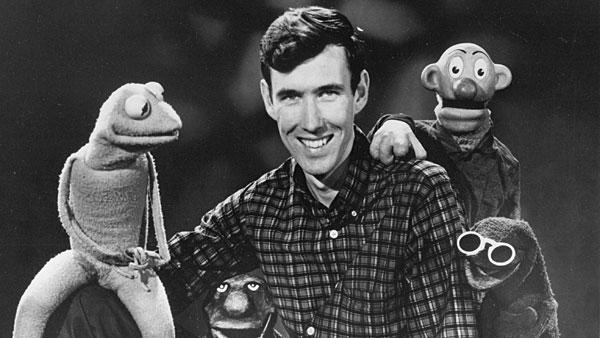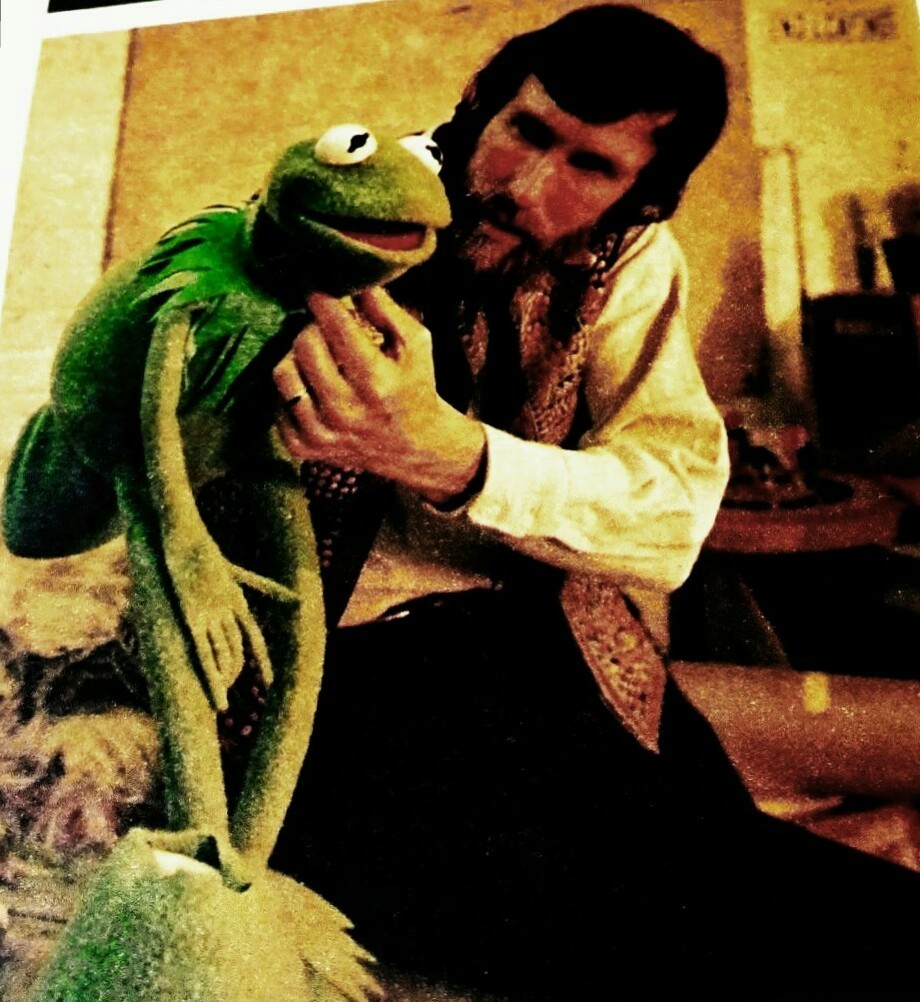Kermit

One in a series of posts dedicated to pop-culture depictions of frogs — as symbolic representations of “too-muchness — from 1904–2003.
The year 1955 is an epic one for pop-culture frog figures, giving us not only Michigan J. Frog but Kermit the Frog — who first appeared on television on May 9, 1955, in the premiere of WRC-TV’s Sam and Friends. (As mentioned above, Toad’s Wild Ride debuted at Disneyland in 1955, too.)

Created (from a turquoise coat and two ping pong ball halves) and performed by Jim Henson, Kermit was for over a decade a vague lizard-like creature. His status as a frog was established in Henson’s 1969 television special Hey, Cinderella!. (This project was the first collaboration of future Sesame Street staffers Henson, Joe Raposo, and Jon Stone.)
Kermit is no rapscallion — instead, he’s a gentle soul, a convener of talent, a wistful songster… much like his creator, Henson himself. He’s a free spirit, waiting for the culture to catch up.

Kermit’s big break came with the popular kiddie TV show Sesame Street (original run, 1969–1990). Around this same time — via the 1969 TV special Hey, Cinderella! — he officially evolved from an amorphous green creature into a frog.
Closely identified with Sesame Street, Kermit appeared as a lecturer on simple topics, a straight man to Grover or Cookie Monster, or a news reporter interviewing storybook characters. He was a gentle, innocent, idealistic character, though… as would become clear in 1970 when he first performed the song “Bein’ Green.”
Henson’s creative partner Joe Raposo wrote “Bein’ Green” for Kermit, and Henson (as Kermit) performed the song. It’s a black-is-beautiful-ish anthem of self-acceptance in a judgmental world. Sample lyrics:
When green is all there is to be
It could make you wonder why
But, why wonder? Why wonder?
I’m green and it’ll do fine
It’s beautiful, and I think it’s what I want to be
The song was included in The Sesame Street Book & Record in 1970, and was a big hit with children and adults alike.
Frank Sinatra would cover the song on Sinatra & Company (1971); Van Morrison on Hard Nose the Highway (1973; click here); Diana Ross on Live at Caesars Palace (1974); and Ray Charles on Renaissance (1975). The latter version would gain popularity with a new generation, years later, thanks to an episode of The Cosby Show.

In 1974 and 1975, Jim Henson would produce pilot episodes — The Muppets Valentine Show, The Muppet Show: Sex and Violence — for a primetime comedy show featuring his Muppets. He was finally able to sell the concept, and The Muppet Show would run from 1976–1981 — there would be 120 episodes in all.
Kermit, in this meta-textual showcase, was the showrunner of a vaudeville theater — struggling to put on a live show each week. Locations were behind the scenes: e.g., backstage right, the dressing rooms, the canteen, the prop room, the recording studio, and the back alley. Major movie and music stars and veteran showbiz personalities appeared as special guests: Steve Martin, Rita Moreno, Dom DeLuise, Ethel Merman, Elton John, Diana Ross, Linda Ronstadt, John Denver…. The show won the 1978 Emmy for Outstanding Comedy-Variety or Music Series.
The success of The Muppet Show led to The Muppet Movie (1979), which opens with Kermit (voiced by Henson) singing “Rainbow Connection” — which was written for the movie by Paul Williams and Kenneth Ascher.
“Rainbow Connection” was a hit — it reached No. 25 on the Billboard Hot 100 in November 1979, and remained in the Top 40 for seven weeks. Williams and Ascher received Oscar nominations for Best Original Song. Here are sample lyrics:
“Rainbows are visions,
But only illusions,
And rainbows have nothing to hide.”
So we’ve been told, and some choose to believe it,
But I know they’re wrong, wait and see.
Someday we’ll find it,
The Rainbow Connection,
The lovers, the dreamers, and me…
Kermit would reprise the song on The Muppet Show in 1980 as a duet with Debbie Harry. The song would also be covered by everyone from Judy Collins, The Carpenters, and Willie Nelson (on his 2001 album Rainbow Connection) to — in 2021 — Barbara Streisand.
Appearing at the apex of the Seventies (1974–1983), “The Rainbow Connection” is a gentle, free-spirited anthem. It also seems to be just about the last gasp — except for the movie E.T. — of the free-spirited frog meme.

